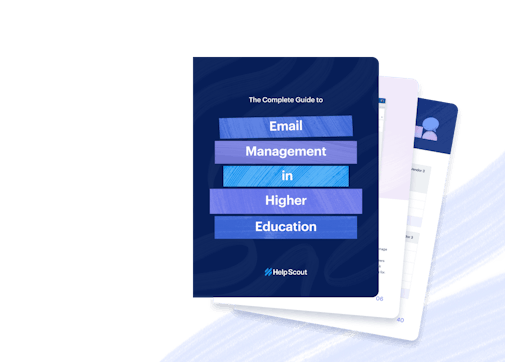11 Tips on Delivering Great Customer Service in Education


When thinking about education, most of us tend to think only about teachers and other administrative staff — frontline workers, so to speak. It makes sense; frontline educators are incredibly important and often underappreciated.
In reality, the education ecosystem is like an iceberg: What you see is just a small fraction of the whole. In order for frontline educators to do their jobs successfully, they need access to things like books, software, and various other supplies.
Some of those items may be pretty self-explanatory, but others require dedicated support professionals to help when the frontline staff have questions. And though on the surface it may seem like they have a standard support role (similar to education as a whole), the truth is there’s a whole lot more to it.
According to a 2018 study, there are 137,432 educational institutions in America ranging from private, charter, and public schools. Each one of these establishments is trying to attract new students each year, and many are realizing that a great student experience starts with excellent customer service.
Along with the standard support responsibilities, there are added challenges unique to the education industry that make providing support more difficult — things like strict privacy laws that govern how you can interact with clients and the need to support an extremely varied base of users, to name a few.
In this article, we cover four major pain points of delivering good customer service in the education industry along with some tips on how to address them.
Pain point #1: Privacy concerns
When working in education, you’ll interact with sensitive information at some point. Many countries have specific privacy laws about processing and handling education-related information. For example, in the U.S., there’s FERPA (Family Educational Rights and Privacy Act).
Laws vary, but they share the same goal: protect the privacy of students. By extension, those working in education support have the same responsibility, and failure to meet that responsibility could result in fines and possible legal action.
Staying in compliance with those laws can be difficult. That said, there are steps you can take to simplify the task to some degree.
Tip 1: Train on the strictest procedures
If you work for a national or international company, chances are there will be multiple sets of privacy laws you need to comply with. Expecting agents to be subject-area experts on all those different laws is a huge ask, and it’s not the most pragmatic solution.
Privacy training needs to be part of any new hire training you do (and realistically, it’s training that everyone in the company should go through). You should ideally have legal counsel present in the training to answer any questions that may come up or to clarify confusing legalese.
Instead of doing a survey course on all the different privacy laws, focus on teaching only the strictest interpretation of the laws that impact how your staff interact with customers. By focusing on the strictest laws, you’re better able to safeguard against potential privacy errors and reduce strain for your staff.
Additionally, consider testing agents' knowledge using quizzes. Research shows tests and quizzes can help with information retention. That said, agents should get multiple attempts at any quiz you give since the main goal is to learn, not to get a specific score.
Tip 2: Find tools with good privacy features
Having a privacy plan in place only works if you also have the proper tools to execute the plan. Many tools have some consideration when it comes to privacy, but since education is stricter than most, not all tools will meet the requirements.
Anytime you’re considering a new tool, make sure you list out the different privacy features you need. For example, being able to redact or remove information is a common feature needed for privacy compliance. You may also want to see if the tool you’re considering is specifically compliant with the laws you need.
Auditing a tool upfront saves time and hassle, so ask questions and get clear answers. If you don’t know what questions to ask, seek out someone who can guide you.
Collaborative email support software
Ditch the shared Gmail and switch to Help Scout’s industry-leading shared inbox. Collaborate easily for faster response times and happier customers.
Try for free
Tip 3: Do regular audits and security refresher courses
Privacy is a moving target. Laws change and new measures may need to be added over time. There’s generally some grace period to get your ducks in a row, but that only lasts so long. When it comes to privacy, being and staying informed are equally important.
As such, you should consider doing yearly or semi-yearly security audits. Scheduling regular audits makes them easier to plan around and less stressful on your team than a sudden audit can be.
Be sure there’s someone responsible for staying informed on current laws to ensure you’re keeping up with the most recent standards. When there is an impending change, do your best to train staff as soon as possible so there’s time to make any necessary adjustments prior to any laws taking full effect.
Pain point #2: Irregular staffing needs
It’s more than possible that support teams working in education will get the same number of requests in the first week of a new school year as they did in the four months prior combined. That makes being properly staffed a bit difficult.
Even if you know the optimal number of staff for a given period, there are still other questions like:
Is it best to only hire permanent staff, or should you utilize seasonal workers, too?
Can your internal team handle hiring, or do you need an outsourcing partner?
If you don’t use seasonal staff, how do you keep agents engaged and productive during lulls?
Properly staffing will always be a more fluid situation for those working in education. That said, answering the questions above can be a great starting point.
Tip 4: Permanent vs. seasonal staff
During our research, we found teams tended to take one of two approaches to staffing: Either all their staff were permanent, full-time employees, or they had a core of permanent staff and hired seasonal staff to help at their busiest times.
The argument for seasonal staff is relatively straightforward. They are less expensive than permanent staff because they’re temporary employees and — depending on where you operate — you don’t have to extend them the same benefits as you do full-time employees.
However, the difference in cost may not be as significant when you take into account the hiring and training resources you need to bring on seasonal staff. Additionally, they may be limited to what conversations they can handle due to a shorter training period.
Since permanent employees have more time to learn, they can develop expertise in multiple areas and can handle more diverse types of requests, so their overall productivity per hour may be higher when compared to a seasonal worker.
For teams with highly complex products that routinely get technical questions, permanent staff may be the better option. For teams where there’s a high volume of more basic requests and who have infrastructure in place to hire and onboard seasonal workers regularly — or have the resources to outsource that responsibility — going the seasonal route may make more sense.
Tip 5: Outsourcing vs. in-house hiring
If you decide hiring seasonal staff is the right move for your team, the next piece to consider is how you’re going to onboard seasonal staff. You can either choose to have an internal team individually hire seasonal workers, or you can employ an outsourcing partner who provides staff to you for a fee.
If you need staff quickly, partnering with an outsourcer is probably a good idea. Hiring for seasonal staff — just as with any other role — can take a long time. Since an outsourcer already has staff, it allows you to get up and running more quickly.
Also, if you’re trying to expand coverage hours — which generally involves hiring internationally — an outsourcer is again a good option. Since you’re not hiring anyone directly, you won’t have to worry about employment laws in different countries.
However, if you’re regularly interacting with sensitive information — obviously quite common in education — in-house hiring may be the better option to retain control. It’s not impossible to outsource, but it may be a bit more complicated in those cases.
Tip 6: Utilizing overflow staff in slow periods
If you decide against seasonal staff, the reality is you will be overstaffed for part of the year. Though having a slow period may sound nice — and it generally is for a short time — after a while it can actually cause staff to disengage.
You may also be pressured to justify the cost of keeping staff during those slower periods. Both are strong reasons why you need to figure out how to use staff effectively during those seasonal lulls.
One very useful support-oriented way to utilize staff during those times is to update and add to your self-service content. Self-service content like help documentation is always useful, and the more robust you can make it, the better. In fact, over 60% of customers prefer it over reaching out to support.
You could also use slower periods for staff to cross-train or learn a specialty within support, like billing. Beyond that, it could be an opportunity for team members to build skills outside their core responsibilities.
For example, if someone’s interested in learning more technical skills, you could find a way for them to work with your product team. If they want to know more about hiring, you could link them with People Operations.
No matter the case, it should help keep team members engaged and also quell any objections senior staff may have to keeping everyone around.
Pain point #3: Supporting a varied base of users
There are many different stakeholders in education. For example, a support agent might get requests from a teacher, a student, a parent, or an administrator.
With such a varied base of users, it can be difficult to adjust to different needs, expectations, and knowledge levels. The following tips can help.
Tip 7: Addressing different stakeholder needs
When you’re serving multiple groups, chances are they’ll have different uses for your product. It’s a similar scenario that support folks face working for marketplace companies like Airbnb or Etsy. Depending on the resources available and the size of your team, there are a few ways to approach the issue.
First, you could create specialized teams. For example, you might have a team that solely works with frontline users of a product — meaning they’re more likely to chat with teachers, students, or parents — and another team that helps with implementation and is more likely to interact with administrators.
If you use a support platform like Help Scout, you can create different knowledge bases for different user groups. That way each has a self-service option that speaks directly to their needs and makes finding answers to their questions quicker and easier.
Tip 8: Supporting people who may not have picked the product
Since many choices are made at the school or district level, it’s not uncommon for the people using your product to have had no say in the choice. And depending on resources, users may not have had much time or training with the product prior to using it.
With that being the case, it’s important for you to do some amount of inquiry to find out where a user is coming from and how much they know. Using a support request form could be a good way to obtain information upfront. Also, be sure to ask questions and don’t assume a certain knowledge level when interacting with customers.
Once you know where they’re coming from, adjust accordingly. Some customers may need a more detailed explanation, while others simply need to be pointed in the right direction for their answer.
By employing empathy, you’re better able to serve anyone who comes through your queue. When you’re thoughtful and present in conversations, you set everyone up for success.
Pain point #4: Prioritizing requests
Properly managing a customer queue can be tricky business. You want to respond in a timely fashion and resolve customers’ issues, but that’s generally easier said than done. In order to tame the queue, you need a plan.
One part of that plan is developing a process to prioritize tickets. By doing so, you remove some guesswork and help improve team efficiency, which is good for everyone involved.
Tip 9: Develop a triage process
If you’re not familiar with the term “triage,” it comes from the medical profession and refers to assessing and determining the severity of a case and the order of treatment for each case.
It’s similar in support. You’re deciding how severe an issue is, how quickly you need to respond, and who is best suited to do the responding.
If you have the resources, it’s useful to have a person — or ideally a team — that actively combs the queue to assign and escalate tickets. However, that job is very difficult to do without guidelines to follow.
Creating a document that guides those choices makes decision-making simpler for your triage team and also helps create consistency. Our customers team documented Help Scout’s triage process if you’re interested in a more in-depth view.
After creating a solid process, you need to roll it out to your team. Remember, it’s only useful if people use it, so be intentional with training and make sure agents are actually using the process.
Also, in cases where you can automate some of the process with workflows, do it. It saves time and energy and also limits errors by removing the human element.
Tip 10: Measure impact
One crucial part of the triage process is measuring the impact of an issue. Impact can be determined in a few different ways, but it usually comes down to how severe an issue is, how many people are experiencing it, and the consequences of said issue.
In theory, higher-impact issues are ones that are severe — meaning they directly impact critical business functions without a clear workaround and involve multiple customers. However, there could be other factors, like if the person experiencing the issue is a large account or pays for priority support.
Properly measuring impact requires you to take all those different factors into account. Similar to the triage process as a whole, it helps to have a guide to determine impact. One popular way is to use a scorecard to see where an issue ranks.
Tip 11: Issue escalation best practices
In the event an issue is severe enough that generalist support agents aren’t able to handle it, they need to escalate the issue to a specialist. Depending on your team structure, you may have specialists within support that you escalate to. In other cases, it may require help from a team outside support.
No matter the case, you should have an organized way to hand off those issues:
Make sure agents add detailed notes. The last thing a customer wants when experiencing an issue is to explain themselves again. By giving more context before handing off, specialists are able to spend more time resolving the issues and less time asking questions.
Have a clear path for escalation. To be as efficient as possible, it helps for everyone to have a clear understanding of what issues go where. Documenting that in an internal knowledge base removes guesswork for agents and gets the right people on the case faster.
Set up a one-to-many communication channel. Having something like a status page is very useful for widespread issues. Not only does it allow you to communicate to a large audience quickly, it also gives agents a place to direct customers for updates and empowers them to stay in the know.
Have people on call. Sometimes critical issues happen outside of standard operating hours. In order to address those, you need people ready. Have a couple people on call from different teams, and be sure to regularly rotate the on-call members to limit additional burden. Also, if they do get called in, make sure they’re able to take additional time off to cover for their extra work.
Creating a system to properly prioritize requests can be challenging, but it is worth the effort. Not only does it mean better service for users, it also means fewer headaches for your team.
Staying ahead of the curve
Getting customer support right in any industry is tough. When you add in the additional challenges support professionals working in education face, it can start to feel outright overwhelming.
Having a plan and approaching each of those issues thoughtfully is what will let you not only survive, but even strive. And though it may feel like a juggling act at times, when you get it right, it’s poetry in motion.
The Complete Guide to Email Management in Higher Education
Take control of your university inboxes to create high-quality experiences for students, faculty, and staff.
Get the guide






